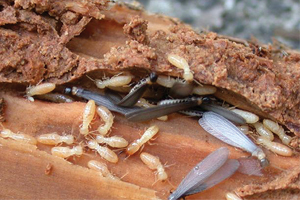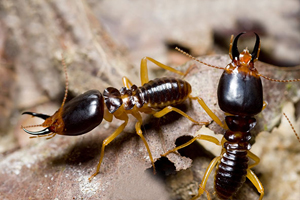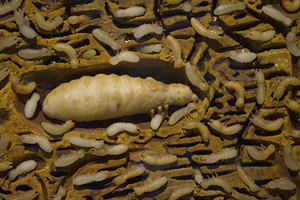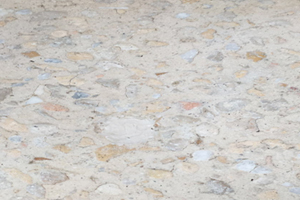Termites are eusocial insects that are classified at the taxonomic rank of infraorder Isoptera, or as epifamily Termitoidae within the cockroach order Blattodea. Termites were once classified in a separate order from cockroaches, but recent phylogenetic studies indicate that they evolved from close ancestors of cockroaches during the Jurassic or Triassic. However, the first termites possibly emerged during the Permian or even the Carboniferous. About 3,106 species are currently described, with a few hundred more left to be described. Although these insects are often called white ants, they are not ants.
Termites are among the most successful groups of insects on Earth, colonizing most landmasses except for Antarctica. Their colonies range in size from a few hundred individuals to enormous societies with several million individuals. Termite queens have the longest lifespan of any insect in the world, with some queens living up to 50 years. Unlike ants, which undergo a complete metamorphosis, each individual termite goes through an incomplete metamorphosis that proceeds through egg, nymph, and adult stages. Colonies are described as super organisms because the termites form part of a self-regulating entity: the colony itself.
 |
 |
 |
 |
Subterranean termites, the most common kind, live in the soil. There are distinct castes within each colony- the largest group being the workers, blind and wingless they bore galleries in wood.
Forage for food and care for other members of the colony. It is the workers, along with newly-hatched nymphs that do the damage to the structure.
Soldier termites protect the colony from attack by invaders such as ants. In its final growth stage, the soldier termites acquires a long armored head and large strong jaws.
Each colony has one queen or more, whose mission is to lay eggs. These develop into new colony members.
There is only one primary queen, but when she dies, secondary queens are often produced.
Once a year new members of the winged reproductive caste develops, a single colony may produce several hundreds of these.
When environmental conditions are ideal, these new Reproductive members leave the colony in a swarm to seek mates and start new colonies. After flying a short distance, the swarm fall to the ground and break off their wings, locate mates and then seek a small space beneath a rock or wood in direct contact with the soil to begin a new colony.
Termite control
OBJECTIVE:
1- Prevent damage to properties and health by insect pests and other vermins
2- Keep pest population within a level below nuisance and economic leve.This standard gives recommendation for the chemical treatment of soils for the protection of buildings from attack by subterranean termites. It includes reference to the chemical to be used, lay down the rate of application for usage, and outlines procedures to be followed while the building is under construction.
Application Procedures:
A-Pre-construction soil treatment
this is a process in which soil treatment is applied to a building during the early stages of its construction to form a chemical barrier.
1. Horizontal Surface:
- Before laying down the concrete slab and after the compaction of the soil, and above the lean concrete or compact gravel, the termiticide is to be applied at the rate 3 liters dilution per square meter. Apply at the rate of 5 liters per square meter to all utility openings of pipes, ducts and all other slab penetration including around expansion joints.4
- Treatment of junction of wall and floor: chemical emulsion will be sprayed at the rate of 5-7 liters per linear meter at the junction of wall/floor.
- The horizontal surfaces where water table is high, the treatment shall be applied on top of the lean concrete to have a chemical barrier which will not be in contact with the existing high water table. Through water table termites cannot infiltrate into the surface but the chemical barrier is recommended, the water table might go down and in such case, this chemical barrier will prevent all termites seeking entry to the building.
2. Vertical Surfaces:
- Refill soil treatment (back filled) to the external walls of basement or excavation of footing up to ground level. To proceed with vertical barrier treatment, the chemical dilution has to contain 0.03% active ingredient and shall be applied at rate of 1 liters per 100 cm depth in a strip of 30 cm width.
Essential Requirements For Barrier And Method Of application:
- Condition of formation - barrier shall be completed and continuous under the whole of the structure to be protected all foundation shall be fully surrounded by and in close contact with the barrier of treated soil, each part of the area treated shall receive the prescribed dosage of the termiticide.
- Time of application - soil treatment should start when foundation trenches and pits are ready to take mass concrete in the foundation. Laying of mass concrete should start when the chemical emulsion has been absorbed by the soil and the surface quite dry.
- Disturbance - once formed treated soil barrier shall not be disturbed, if by chance treated soil barriers are disturbed immediate steps shall be taken to restore the continuity and completeness of the barrier system.
B- Post Construction Anti Termite Treatment – Creating chemical barrier
EVIDENCE OF TERMITE INFESTATION
SWARMS that occur within a building are positive evidence that the structure is infested.
SWARMERS are attracted to light and are often seen in large numbers around windows.
GALLERIES IN WOOD. Wood damaged by termites has galleries that tend to run with the grain, although some will cross the grain, these galleries can be distinguished from similar damage
caused by other wood infesting insects because they usually contain soil particles instead of sawdust. MUD TUBES are also evidence of an infestation. When termites cross concrete and similar materials to reach wood, they construct these tubes as a shelter. The tubes are made of soil particles cemented together with saliva and excreted fluid waste.
SOIL PASSAGES. Termites feed on wood and cellulose materials, but they also need constant moisture to survive. Colonies usually nest in the soil which provides that moisture. MOIST WOOD and wood which is in direct contact with the soil such as under a dirtfilled porch, provide ideal conditions for termites.
APPLICATION PROCEDURES:
lnside the Building:
Drilling 20 mm diameter holes at 30 cm intervals to reach the soil below the slab at the point where there is evidance of termite infestation, then all the holes to be injected with 1-2 liters of termiticide solution and then to be sealed with concret and the top of the hole where the tile is to be sealed with mixture of the tile powder and glue.
At the following locations:
A) Door frame at the contact with floor tiles.
B) at the junction of the floor and walls as results of shrinkage of the concrete.
Outside the Building:
Drilling 30 mm diameter holes at 30 cm intervals to reach the soil below the slab / interlock tiles with depth of 60 cm to reach the foundation below, then 2-3 liters of termiticide solution to be injected in each hole, then to be sealed accordingly. Trench to done at sandy perimeter with depth of 60 cm and width of 30cm then the trench to be treated with termicide solution at rate of 5-7 liters per runing meter, then the backfill soil to be treated with the same solution when itis applied back.
| Stage 1: drilling holes 20 mm | Stage 2: injecting the chemical solution |
 |
 |
 |
 |
| Stage 3: injection the hole with special cement | Stage 4: sealing the hole |

